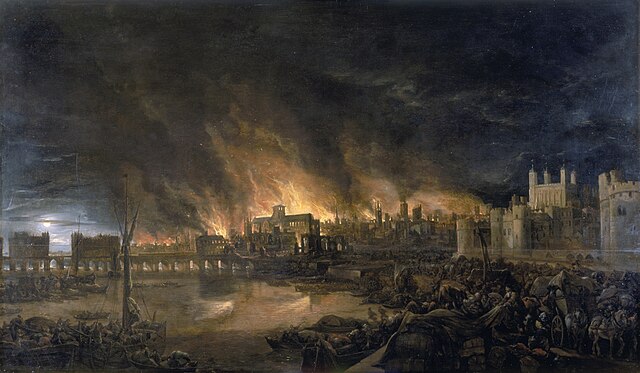
Where did the Great Fire of London start? The Great Fire of London started in a baker’s shop in a road called Pudding Lane. It burned for five days.
The Great Fire of London started on Sunday, 2nd September 1666 and it was finally extinguished on Thursday, 6th September. It destroyed over 13,000 homes, 87 churches, the Royal Exchange, the Custom House, Bridewell Palace, several prisons, the General Letter Office, three city gates, and St. Paul’s Cathedral. The fire itself didn’t kill many people. Numbers vary, but the official figure was only 6 people. This number is probably too low because a lot of people didn’t report deaths, there were so many poor people that were basically undocumented, and there was just no way to check. There were also a lot of immigrants and refugees living in the city that would have left no trace. A lot of people died during the harsh winter that followed the Great Fire as well because they didn’t have anywhere to live and there was not enough food. Some people at the time said the death toll might even be in the thousands. The monetary damage was estimated at 10 million pounds, which is approximately 2 billion pounds, or 2.5 billion dollars today.
So, how and where did the Great Fire of London start? The fire started in a bakery located on Pudding Lane. It is called Pudding Lane because it was the road that butchers used to use to get transport offal from the market at Eastcheap to the river. Offal was also known as pudding. The bakery where the fire started was owned by Thomas Farriner and he opened it in 1649. He was a very well-known baker and provided bread for the Royal Navy and sometimes the Royal Family. On September 2nd, Thomas Farriner was woken up by another baker who worked for him and lived above the bakers. This man’s name was Thomas Dagger. The house was full of smoke coming from downstairs and all of the inhabitants in the house escaped through a window. Their maid died in the fire.
The fire spread from their bakery to the houses on either side. People were used to fires at the time because all of the houses were made of wood and they burned easily. Fires usually went out pretty quickly. This one, though, didn’t go out. It continued to spread. The summer had been particularly hot and dry, which meant the houses burned more easily. It was also very windy when the fire started, which blew the fire from house to house. Several warehouses full of oil and tallow caught fire, which spread the fire even further. There was also no fire service to deal with the fire. Local groups of people joined together to try to combat it, but there was no centralized fire brigade. The Lord Mayor of London ordered houses to be pulled down to make a fire break, but his orders were too late and not enough. The fire easily jumped these breaks and carried on burning. Finally, the wind dropped, the Lord Mayor’s men were able to make enough fire breaks, and the fire hit areas of the city that had been burned down in fires fifteen years earlier. The fire gradually died out, although it continued burning in certain areas for a long time.
There were two investigations that looked into the cause of the fire, but they both wanted to find scapegoats. The first investigation blamed a Frenchman called Robert Hubert, who was executed for starting the fire. It turned out he was not even in London then. The second investigation wanted to blame the Catholics. Both of these investigations had different motives, but they both acknowledged that the fire started in the bakery in Pudding Lane.
As most people would probably do in the same situation, Thomas Farriner didn’t want the blame for this fire that had destroyed 15% of the city. Farriner claimed that he put the fire in their ovens out in the evening. Then, he said, he woke up in the middle of the night and wanted to light a candle, but there wasn’t even enough heat in the oven to light a candle. His claim was that someone had broken into his bakery and started the fire on purpose. Documents from the time show that there were five people in the house above the bakery when the fire started. These were Thomas Farriner, his son Thomas Farriner jr, his daughter Hanna Farriner, his maid, and the baker who worked for him Thomas Dagger. Everybody was asleep when Thomas Dagger was awoken by the smoke. He roused everyone else, and they all escaped, apart from the maid.
After the fire, the three Farriners and Thomas Dagger appeared as witnesses against Robert Hubert, the Frenchmen they accused of starting the fire. They said that they had overheard his confession in the bakery. Hubert later confessed, which was the reason he was hanged, but it turned out he was probably not mentally able to stand trial and was not even in the country until after the fire had started. Why would the Farriners say they had heard his confession if they hadn’t? The only reason I can think of is that the fire started in their oven by accident and they didn’t want the blame. Thomas Farriner died a few years after the fire, and his name has been forever associated with the Great Fire of London. Thomas Dagger set up his own bakery in London and lived a long life. He was the first person to witness the fire. Did he start it? Or just find it? I guess we will never know. And this is what I learned today.
Sources
https://pepyshistory.le.ac.uk/who-discovered-the-great-fire
https://le.ac.uk/news/2023/september/fire-of-london
https://www.themonument.org.uk/great-fire-london-faqs
https://www.london-fire.gov.uk/museum/history-and-stories/the-great-fire-of-london
https://en.wikipedia.org/wiki/Great_Fire_of_London
https://en.wikipedia.org/wiki/Thomas_Farriner
https://en.wikipedia.org/wiki/Pudding_Lane
https://www.londonmuseum.org.uk/blog/how-the-great-fire-of-london-created-insurance
Image By Josepha Jane Battlehooke – museumoflondonprints.com, Public Domain, https://commons.wikimedia.org/w/index.php?curid=1303944
